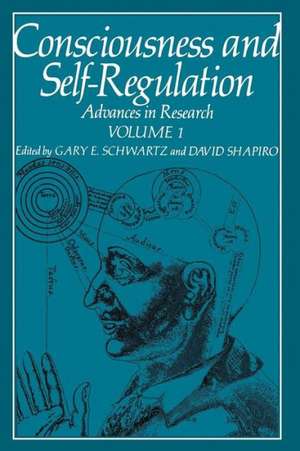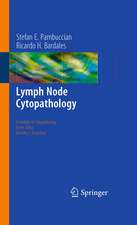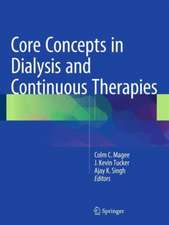Consciousness and Self-Regulation: Advances in Research Volume 1
Autor Gary Schwartzen Limba Engleză Paperback – 8 mar 2012
| Toate formatele și edițiile | Preț | Express |
|---|---|---|
| Paperback (2) | 374.57 lei 6-8 săpt. | |
| Springer Us – 8 mar 2012 | 374.57 lei 6-8 săpt. | |
| Springer Us – 25 noi 2012 | 397.01 lei 6-8 săpt. |
Preț: 374.57 lei
Preț vechi: 394.29 lei
-5% Nou
Puncte Express: 562
Preț estimativ în valută:
71.68€ • 74.56$ • 59.18£
71.68€ • 74.56$ • 59.18£
Carte tipărită la comandă
Livrare economică 14-28 aprilie
Preluare comenzi: 021 569.72.76
Specificații
ISBN-13: 9781468425703
ISBN-10: 1468425706
Pagini: 424
Ilustrații: XXII, 400 p. 55 illus.
Dimensiuni: 152 x 229 x 22 mm
Greutate: 0.56 kg
Ediția:Softcover reprint of the original 1st ed. 1976
Editura: Springer Us
Colecția Springer
Locul publicării:New York, NY, United States
ISBN-10: 1468425706
Pagini: 424
Ilustrații: XXII, 400 p. 55 illus.
Dimensiuni: 152 x 229 x 22 mm
Greutate: 0.56 kg
Ediția:Softcover reprint of the original 1st ed. 1976
Editura: Springer Us
Colecția Springer
Locul publicării:New York, NY, United States
Public țintă
ResearchCuprins
1 A Model of Consciousness.- I. Levels of Information.- II. A Personal Research Strategy.- III. EEG Studies.- IV. Average Evoked Potentials.- V. Unit Studies.- VI. Brain Stimulation Studies.- VII. Theoretical Discussion of Electrophysiological Evidence.- 2. Self-Consciousness and Intentionality: A Model Based on an Experimental Analysis of the Brain Mechanisms Involved in the Jamesian Theory of Motivation and Emotion.- I. A Neurobehavioral Analysis of Brain Mechanisms in Motivation and Emotion.- II. The Role of Attention in Motivational and Emotional Reactions.- III. Effort and the Expression of Motivation and Emotion.- IV. A Control-Theory Model of Self-Regulation and Self- Consciousness.- 3. Self-Regulation of Stimulus Intensity: Augmenting/ Reducing and the Average Evoked Response.- I. Introduction.- II. Sensory Experience and Augmenting/Reducing.- III. Amplitude/Intensity Relationships in Man.- IV. Augmenting/Reducing Reliability and the Measurement of the AER.- V. Genetic Factors in Augmenting/Reducing.- VI. Tolerance for High-Intensity Stimulation.- VII. Effects of Arousal, Attention, and Sensory Overload.- VIII. Individual Differences and Intensity Judgments.- IX. Sensory Sensitivity and “Strength of the Nervous System”.- X. Self-Regulation and Sensory Homeostasis.- 4. Neodissociation Theory of Multiple Cognitive Control Systems.- I. Pierre Janet’s Theory of Dissociation.- II. Why a Neodissociation Theory?.- III. The Hypnotic Model.- IV. Neodissociation Model of Multiple Cognitive Control Structures.- V. Empirical Approaches to Multiple Control Structures and Divisions of Consciousness.- VI. The Duality of Responsiveness to Pain as Related to Neodissociation Theory.- VII. Conclusion.- 5. Hypnotic Susceptibility, EEG-Alpha, and Self-Regulation.- I.Introduction.- II. The Assessment of Hypnotic Susceptibility.- III. Stability of Hypnotic Susceptibility.- IV. Modification of Hypnotic Susceptibility.- V. Hypnotic Susceptibility and Personality.- VI. Hypnosis and the EEG.- VII. EEG and Hypnotic Susceptibility: Indirect Relationships.- VIII. EEG and Hypnotic Susceptibility: Direct Evidence.- IX. The Stability of EEG Base Rates.- X. Increasing Susceptibility by EEG Feedback.- XI. Changes in EEG during Hypnosis.- XII. Task-Specific EEG Changes.- XIII. Conclusions.- 6. Toward a Cognitive Theory of Self-Control.- I. Introduction.- II. Conclusions from Treatment.- III. A Cognitive Theory of Self-Control.- IV. Summary.- 7. Physiological and Cognitive Processes in the Regulation of Anxiety.- I. A Descriptive Model of Anxiety Process.- II. Research Studies on the Maintenance and Reduction of Anxiety.- III. Summary and Conclusions.- 8. Dreaming: Experimental Investigation of Representational and Adaptive Properties.- I. Dream Recall.- II. Representational Properties of Dreaming.- III. Functional Properties of Dreaming.- 9. Biofeedback and the Twilight States of Consciousness.- I. The Twilight State.- II. Future Considerations.- Author Index.











